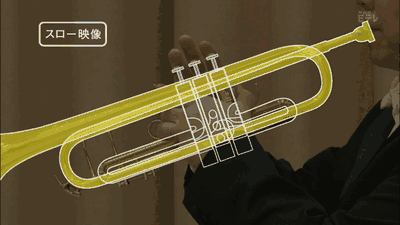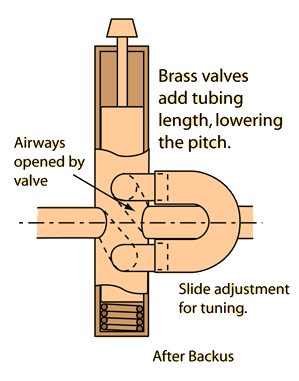"People compose for many reasons: to become immortal;
because the pianoforte happens to be open; because they
want to become a millionaire; because of the praise of
friends; because they have looked into a pair of beautiful
eyes; for no reason whatsoever."
AUTHOR: Robert Schumann
MEANING OF THE QUOTE:
"People create art for varied reasons.
For everyone the reason is different."



Baroque Trumpet
By making the trumpets and forming an ensemble to
play pieces from the 17th century, Proksch hopes to
restore the natural trumpet to its rightful role. "The
reason we are interested in the natural trumpet is more
than purely historical," Proksch insists. "It actually
sounds better than the modern trumpet. If you
want to hear music the way Bach heard it,
you at least have to have
the right instrument."
MEANING OF THE QUOTE:
"People create art for varied reasons.
For everyone the reason is different."
DOUBLE TRUMPET CONCERTO
C MAJOR RV. 537 OPUS 46 NO. 1
C MAJOR RV. 537 OPUS 46 NO. 1
Maurice Andre, Trumpet
Neville Marriner, Conductor
Neville Marriner, Conductor



Baroque Trumpet
Baroque Trumpet and Crooks
Baroque Natural Trumpet (top)
Vs. Modern Valved Trumpet
ABOUT THE TRUMPET:


 By Elizabeth Jin
By Elizabeth Jin
September 1, 2002
Natural trumpets. Trumpets made out of dirt and weeds?
Wrong. They're made out of brass like any other trumpet.
"A natural trumpet is essentially a trumpet without valves,"
Bryan Proksch, a graduate student in musicology, or the
study of the history of music, explains. He sits up straight
and reaches for his trumpet case. The instrument that comes
out of the case looks nothing like a modern trumpet—it is
almost twice as long and has no valves.
Proksch jumps up and grabs the telephone on his desk. He
straight tube about 47 inches long with a flared end.
Aptly named, the signaling trumpet's splendid sound could be heard
at great distances and was useful in military battles and royal fanfares.
The natural trumpet performed similar functions as the
signaling trumpet; however, instrument makers folded its
88 inches of tubing to make it more convenient to carry
on military campaigns and to court functions.
The trumpet's function would have remained military if not for an
important event in the trumpet's history: its acceptance into art
music in the 17th century. The natural trumpet flourished during
this time, with eminent composers such as J. S. Bach and Johann
Schelle writing pieces in which trumpets led the melody.
Valentine Snow
Proksch recently edited a set of his natural trumpet
duets, which was published by Brass Press.
Yet by 1770, composers such as Beethoven and Mozart had
ushered in a more complex musical sound with several key
changes in one piece. A natural trumpeter must change the
instrument's mouthpiece in order to change keys. The impracticality
of this requirement reduced the trumpet's role to opening flourishes and
climaxes until the valve trumpet was invented around 1815. Unlike
the natural trumpet, it can change keys without changing
the mouthpiece and is easier to play in tune
because it requires less lip tension.
Despite the pleasing, clear tone of the modern valve trumpet,
Proksch insists that it is not what Bach and his contemporaries
intended their robust and somewhat unrefined trumpet parts to
sound like. Proksch's desire to play these pieces properly
prompted him to learn how to play the natural trumpet. Better yet,
he decided to make one. Even better, he decided to recruit other
natural trumpeters in the hopes of creating a natural trumpet ensemble.
Last spring, along with two undergraduate music majors, Derek Bittner
and Edward Jakuboski, Proksch obtained a grant from the university to
build six natural trumpets. Professor Leslie Leupp from the School of
Visual Arts, the Department of Metal Arts, and Engineering Services
assisted in the project by donating their facilities and materials.
How to Make a Baroque Trumpet
 |
| http://www.fraize-marques.com/en/instruments-anciens.php |
Vs. Modern Valved Trumpet
 |
| http://music.yale.edu/2011/04/01/student-viewpoint-master-class-in-natural-trumpet/ |



Bach to Basics
September 1, 2002
Wrong. They're made out of brass like any other trumpet.
"A natural trumpet is essentially a trumpet without valves,"
Bryan Proksch, a graduate student in musicology, or the
study of the history of music, explains. He sits up straight
and reaches for his trumpet case. The instrument that comes
out of the case looks nothing like a modern trumpet—it is
almost twice as long and has no valves.
 |
| Johannes Vermeer: The Art of Painting (detail) |
On a modern trumpet, the three valves are connected to thin
pieces of tubing. These little tubes connect to the larger tube
that makes up the horn. However, the little tubes remain
closed until the player presses a valve, which opens the
passageway to a tube, elongating the path that the air travels.
Proksch compares the phenomenon to blowing
pieces of tubing. These little tubes connect to the larger tube
that makes up the horn. However, the little tubes remain
closed until the player presses a valve, which opens the
passageway to a tube, elongating the path that the air travels.
The longer the air path, the lower the
sound that comes out of the horn.
sound that comes out of the horn.
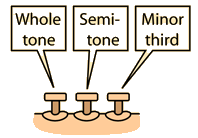 |
| The three valves of the trumpet add lengths of tubing to the instrument to lower the pitch. The first valve lowers it by a whole tone, the second by a semitone, and the third by a minor third. |
across a Coke bottle. The less liquid you have in the bottle,
the longer the "air path," and the lower the resulting sound,
By using a combination of valves, a modern trumpeter can
produce every note on a musical scale. The natural trumpet
has no valves; instead, through subtle adjustments in lip
tension, a natural trumpeter produces the notes of a harmonic
scale, a set of selected tones that are "fixed by nature."
 |
| http://www.physchem.co.za/OB11-wav/sound3.htm |
shakes the phone cord, creating a series of waves.
"Imagine that one wave is equal to the note created using the
smallest amount of lip tension. On a C scale—a series of eight
notes beginning and ending with C—that note is C," he explains.
He then shakes the cord harder and the waves double in
frequency. The next note on the harmonic scale is "double" a C,
or the C an octave higher. Shaking the cord even harder—
the equivalent of adding more lip tension—creates a wave
that is a fifth of the frequency of the original wave.
The natural trumpet evolved from the signaling trumpet, a single,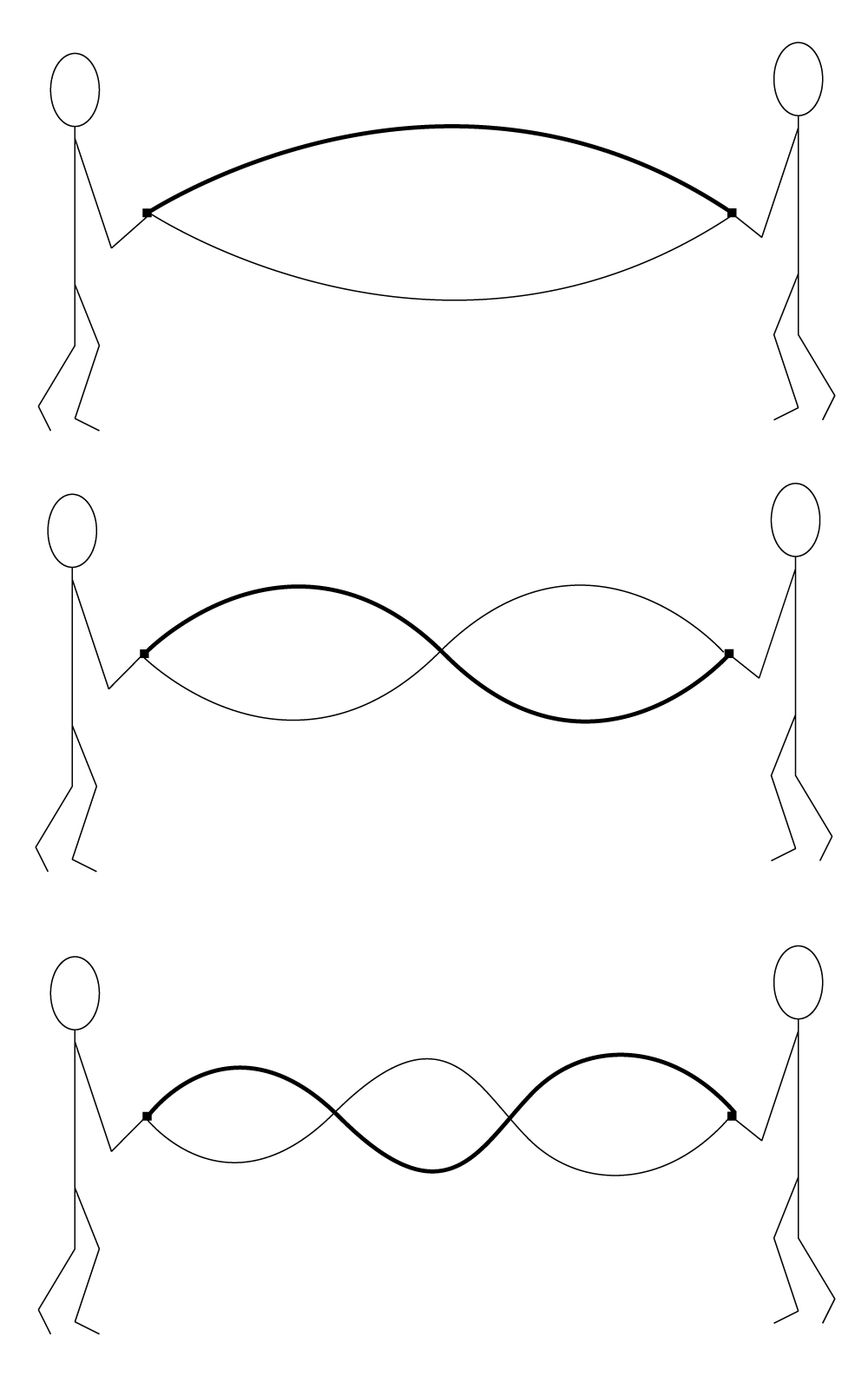 |
| Vibrating a rope at resonant frequencies |
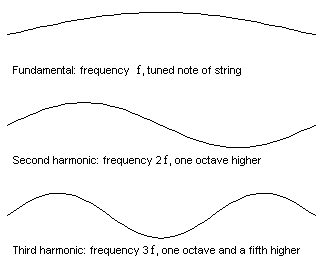 |
| http://plus.maths.org/content/why-violin-so-hard-play |
smallest amount of lip tension. On a C scale—a series of eight
notes beginning and ending with C—that note is C," he explains.
He then shakes the cord harder and the waves double in
frequency. The next note on the harmonic scale is "double" a C,
or the C an octave higher. Shaking the cord even harder—
the equivalent of adding more lip tension—creates a wave
that is a fifth of the frequency of the original wave.
straight tube about 47 inches long with a flared end.
Aptly named, the signaling trumpet's splendid sound could be heard
at great distances and was useful in military battles and royal fanfares.
 |
| Jean Fouquet: The Battle of Jericho (fl. 1470-1475) Notice the use of signaling trumpets. |
signaling trumpet; however, instrument makers folded its
88 inches of tubing to make it more convenient to carry
on military campaigns and to court functions.
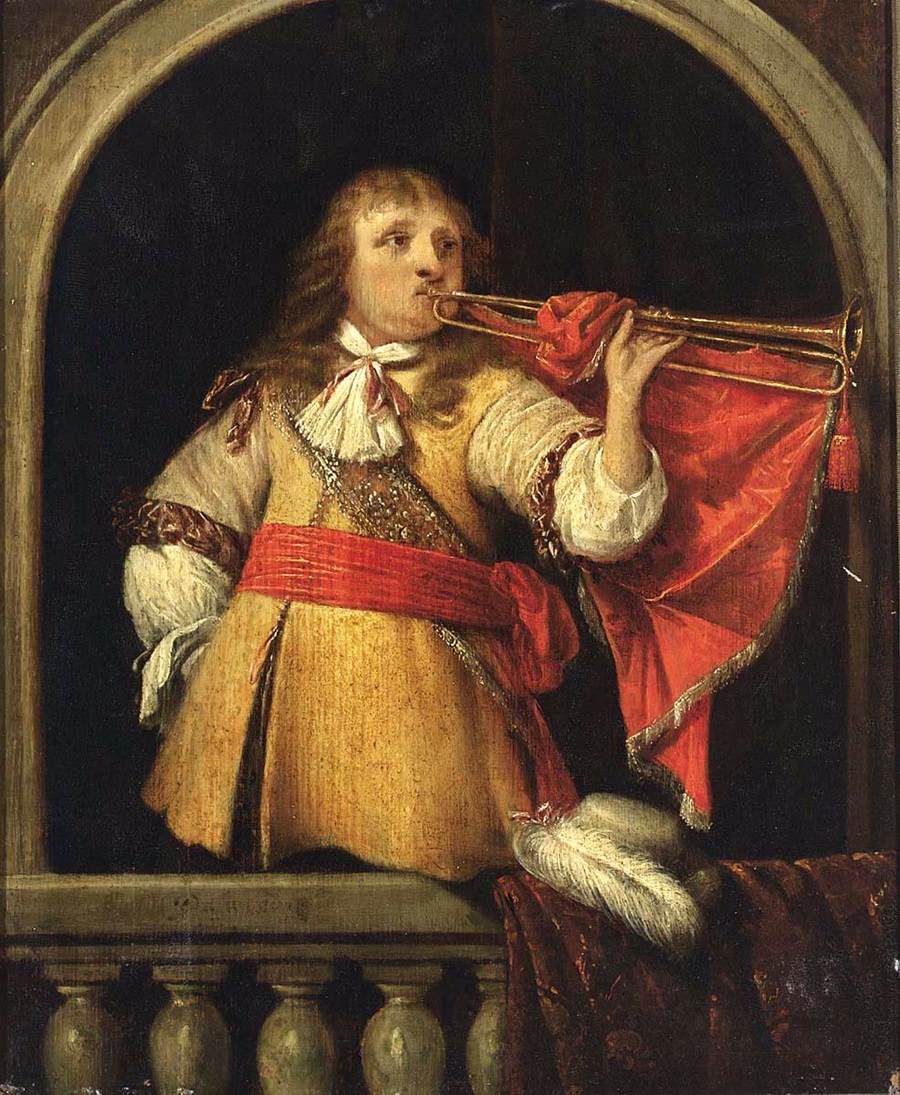 |
| Anthonie Palamedesz: An Officer Blowing a Trumpet |
important event in the trumpet's history: its acceptance into art
music in the 17th century. The natural trumpet flourished during
this time, with eminent composers such as J. S. Bach and Johann
Schelle writing pieces in which trumpets led the melody.
Valentine Snow
 |
was one such natural trumpeter
wrote most of his music; Snow was also a composer, andProksch recently edited a set of his natural trumpet
duets, which was published by Brass Press.
ushered in a more complex musical sound with several key
changes in one piece. A natural trumpeter must change the
instrument's mouthpiece in order to change keys. The impracticality
of this requirement reduced the trumpet's role to opening flourishes and
climaxes until the valve trumpet was invented around 1815. Unlike
the natural trumpet, it can change keys without changing
the mouthpiece and is easier to play in tune
because it requires less lip tension.
Proksch insists that it is not what Bach and his contemporaries
intended their robust and somewhat unrefined trumpet parts to
sound like. Proksch's desire to play these pieces properly
prompted him to learn how to play the natural trumpet. Better yet,
he decided to make one. Even better, he decided to recruit other
natural trumpeters in the hopes of creating a natural trumpet ensemble.
Last spring, along with two undergraduate music majors, Derek Bittner
and Edward Jakuboski, Proksch obtained a grant from the university to
build six natural trumpets. Professor Leslie Leupp from the School of
Visual Arts, the Department of Metal Arts, and Engineering Services
assisted in the project by donating their facilities and materials.
 |
| A Natural Trumpet Ensemble: Humboldt Trumpet Ensemble |
"Making a natural trumpet is a lot simpler than you might think,"
Proksch says. Humming a Bach concerto, he riffles through
some sheet music on the piano and finds scrap paper to draw
on. "First," he says, "you cut a big sheet of brass." This piece
will become the bell of the trumpet. He sketches a pattern of a
trumpet bell that is about a yard long and looks as if it has been
run over by a truck. He continues, "Next, cut out the pattern and
make teeth marks along the two long sides." The two sides will
eventually be connected; the interwoven teeth create a stronger
fit than if two straight sides were simply welded together. Now,
fold the pattern in half lengthwise and open it slightly at one end
to fit on a mandrel, a big piece of curved steel. Finally, hammer
out the bell into its proper curved shape.
Smaller brass tubes make up the rest of the natural trumpet. The
joints are pressure-fitted by tapering the end of one tube slightly
and expanding the end of the other. A discovery in tube bending
shortly before the 1400s allows the brass to be curved. Brass has
a melting point of 1083 degrees C, while lead melts at 327 degrees
C. Consequently, lead melts and cools more quickly than brass.
Filling a straight piece of brass tubing with liquid lead allows the
brass to bend but not melt. After bending the tubing, the cooled
lead is melted again and removed. Today, because lead is
poisonous, trumpet makers use an alloy made of bismuth, which
melts even before water boils.
Natural Trumpet
with Period Mouthpiece
Handel: The Trumpet Shall Sound
(Opening Solo Passage)
with Period Mouthpiece
Handel: The Trumpet Shall Sound
(Opening Solo Passage)
play pieces from the 17th century, Proksch hopes to
restore the natural trumpet to its rightful role. "The
reason we are interested in the natural trumpet is more
than purely historical," Proksch insists. "It actually
sounds better than the modern trumpet. If you
want to hear music the way Bach heard it,
you at least have to have
the right instrument."
 |
| Bryan Proksch |
Bryan Proksch is a master's degree student in musicology in the
School of Music within the College of Arts and Architecture, 233
Music Bldg. I, University Park, PA 16802; 814-863-4421;
bjp176@psu.edu. Derek Bittner and Edward Jakuboski are
undergraduate students, both majoring in music. The natural
trumpet project is funded by an undergraduate research grant
from the College of Arts and Architecture.
http://www.vsl.co.at/en/70/3139/3143/3144/5421.vsl
http://news.psu.edu/story/140705/2002/09/01/research/bach-basics
http://home.adelphi.edu/~tb16936/page5.html
http://www.earlybrass.com/NATTRUMPpage.htm
http://www.wisegeek.com/what-is-a-baroque-trumpet.htm
http://en.wikipedia.org/wiki/Baroque_trumpet
http://musiced.about.com/od/lessonsandtips/a/trumpethistory.htm
http://www.virtualtrumpetstudio.com/HistoryofTrumpet.htm
http://jaz.wikia.com/wiki/Trumpet_History
http://www.thein-brass.de/Thailand.html
http://www.philharmonia.org/learn-and-listen/baroque-instruments/trumpet/
http://www.trumpetguild.org/_72820_archive/2002journal/0203natural.pdf
http://www.essentialvermeer.com/music/trumpet.html#.VMNTu_7F98G
http://www.willcwhite.com/2011/05/cso-addenda-trumpet-treasures/



http://news.psu.edu/story/140705/2002/09/01/research/bach-basics
http://home.adelphi.edu/~tb16936/page5.html
http://www.earlybrass.com/NATTRUMPpage.htm
http://www.wisegeek.com/what-is-a-baroque-trumpet.htm
http://en.wikipedia.org/wiki/Baroque_trumpet
http://musiced.about.com/od/lessonsandtips/a/trumpethistory.htm
http://www.virtualtrumpetstudio.com/HistoryofTrumpet.htm
http://jaz.wikia.com/wiki/Trumpet_History
http://www.thein-brass.de/Thailand.html
http://www.philharmonia.org/learn-and-listen/baroque-instruments/trumpet/
http://www.trumpetguild.org/_72820_archive/2002journal/0203natural.pdf
http://www.essentialvermeer.com/music/trumpet.html#.VMNTu_7F98G
http://www.willcwhite.com/2011/05/cso-addenda-trumpet-treasures/



 |
| Anthonie Palamedesz: Interior of a room, a guard officer with a trumpet and a mother with a child. |



